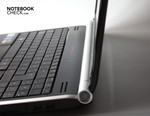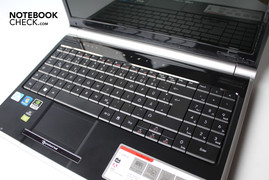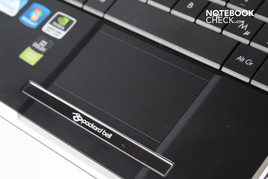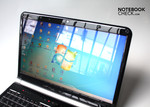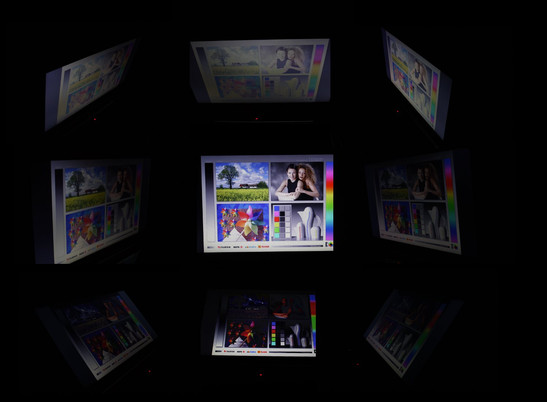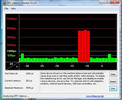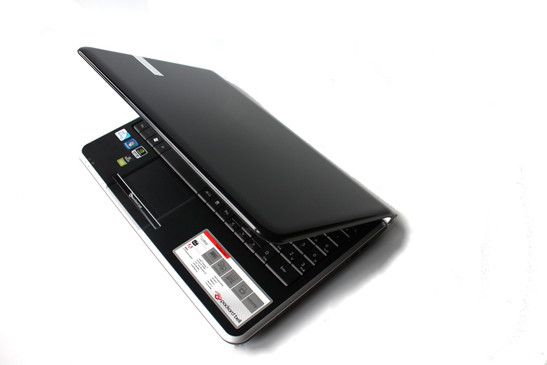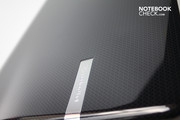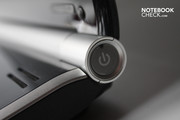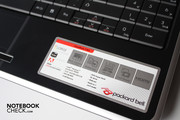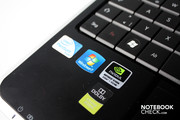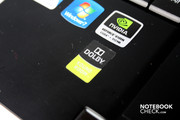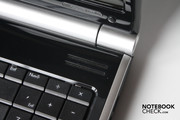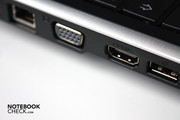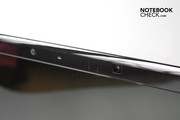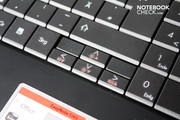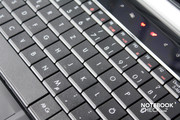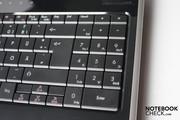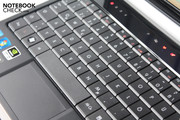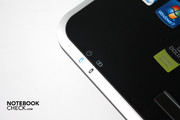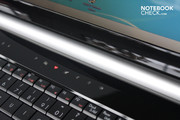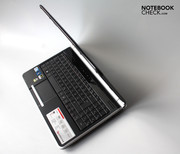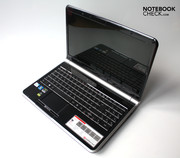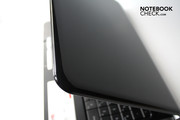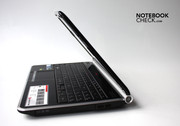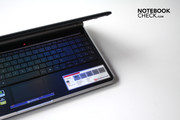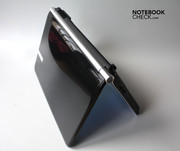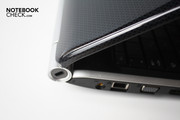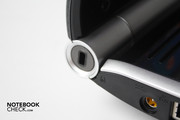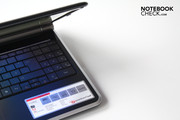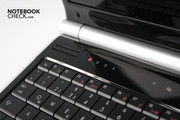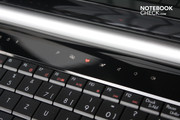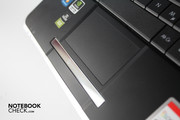Review Packard Bell EasyNote TJ65 Notebook
Second League?
Packard Bell wants to principally score by those customers who want to a play bit, work a bit but especially want a lot of multimedia. The value for money ratio should also be alright. Will the TJ65 turn out to be a cheapskate or can it supply solid quality for a fairly low price?
Packard Bell has belonged to the notebook giant Acer as a standalone brand for about two years. Since then Packard Bell has been supplying the budget line because they naturally don't want to compete against themselves. Thus, the objectives are especially a good value for money ratio without extraordinary workmanship and special materials.
The EasyNote TJ is probably Packard Bell's notebook range that is soonest supplying the multimedia mainstream: A 15.6 inch display suitable for the masses, middle class graphic card, dual-core processor - too little for the demanding gamer but too much performance for the pencil pusher.
First there are six different configurations for the TJ range displayed on Packard Bell's homepage. Starting with an Athlon X2 with 2 GHz and a Radeon 4570 over an Intel Core 2 Duo and an Nvidia Geforce G 105M up to the top models with a Geforce GT 240M graphic card - there should be something for every multimedia fan.
Our configuration alternative isn't found on Packard Bell's German homepage. The start into the Easynote TJ range is made by a Pentium Dual Core processor with the model name T4300 and 2.1 clock rate. The already mentioned Geforce G105M with a 512 MByte memory is used as the graphic card. This combination officially has the somewhat unwieldy name Packard Bell Easynote TJ 65-CU-075GE. The price lies around 550 euro. By the way, in the internet there are also models with Intel's onboard graphic card GMA 4500M HD available but the price difference to our configuration is only slight.
Case
Principally, you can only expect one material for this low price: plastic. The EasyNote TJ offers plenty of it and in a several options - whether as a chrome imitation of Packard Bell's logo on the case lid, as a matt, silver shimmering case border or as a glossy display bezel: everything's plastic.
However, it is stable and supplies the case with a good stability. Creaking noises are just as absent as deformations are when you lift the notebook on one edge. Even the keyboard fits tight and doesn't yield anywhere. The display lid allows the display to be twisted slightly, but just like pressure from the back, evident image interferences don't turn up. Generally, the chassis has been assembled very compactly and stably.
Even touching the Easynote TJ is fun. The keyboard bezel's bottom half is made in a matt black plastic that feels pleasant. Black high-gloss gleams at you above the keyboard, which contains a few touch sensitive buttons, for instance for volume control or disabling WLAN. These buttons are backlit with red diodes, whilst both status lights on the case's lower edge have a blue light.
In summary, the design of the Easynote presents itself as quite reserved and should thus satisfy quite a few tastes. A little highlight is also the display lid, which is coated with a honeycomb pattern and contains a Packard Bell logo in a chrome look. There are also further color alternatives for the case. A few models are available with a white interior or a red exterior.
The monitor's hinge is made as a round, silver plastic element that runs over the entire width. It provides enough resistance to keep the display stably in position in every situation and to adjust it after a short teetering. The lid is also kept in a closed state only by the hinge. You need quite a lot of strength to open the monitor and won't be able to singlehandedly.
Connectivity
Although the front and rear would have been available for connections, Packard Bell has decided to build in all interfaces on the notebook's sides. The notebook has a good connectivity anyway.
On the left, from front to rear, are found: A 5-in-1 cardreader that gets along with SD-, MMC-, Memory Stick, Memory Stick Pro and xD cards. It's followed by a 3.5 mm headphone-out with S/PDIF support, a microphone-in, two USB 2.0 connections, an HDMI port, a VGA connection, the LAN socket, followed by the DC-in and a Kensington lock arrangement built into the hinge's side.
On the right, also from front to rear, are found: The DVD burner, two USB 2.0 connections and the power button.
The port distribution has also been well selected. You find USB ports on both sides so that you can connect your devices on the side where they won't be very disturbing. The ports aren't as good for lefties because the majority of connections are on the notebook's left and annoying cables get into the way of their mouse hand. Incidentally, the air-outputs are found on the notebook's left front and rear.
The Packard Bell engineers have only integrated WLAN in our prototype as a wireless interface; Bluetooth is available as optional equipment. WLAN runs over a card from Atheros. The AR5B93 is capable of the standards: 802.11 a/g and also the new standard 802.11 n. Thus, it should be future-proof for the next few years.
The DVD burner comes from Sony-Optiarc. It reads and writes DVDs with an 8-fold velocity and CDs with a 24-fold velocity.
Software
Unfortunately, aside from a few high-end full versions, such as Adobe Photoshop Elements 7.0 or Nero Smart Start Essentials, there are a few trial versions and further bloatware onboard. Norton Online Backup would like to help you save your data online, but can only do that for one month for free. Afterwards you have to pay for it. Norton Security is also only available for free for a limited time and the Metaboli video games that you can download with the according program have to be purchased after a certain trial period, too.
At least, the DVD player PowerDVD 8 and backup software from Packard Bell, with which you can create a recovery DVD, are installed. Namely, there isn't any recovery media found in the carton for the operating system, Windows 7 Home Premium 64 bit. In any case, Packard Bell adds a completely unmarked and, as we established after inserting it into the drive, also blank DVD in the carton, on which you are probably supposed to burn your own recovery DVD.
Input Devices
Keyboard
Due to the display's rather wide 16:9 format, Packard Bell can build in a complete keyboard including a numerical block into the Easynote TJ. Also agreeable is that you don't have to fall back on "Fn" keys for any of the important functions. Actually, the same keys are found on the keyboard as on a normal one.
The single keys are separated by lowered edges and make a fast and also pleasant typing possible. However, the key stroke is very stiff and abrupt. Fans of a gentle typing feel won't be satisfied. In return, the keys sit tight in the case, have a big size and are there where you'd expect them.
The arrow keys are apparent as special functions, which control volume and display brightness in combination with the "Fn" key. Otherwise, you can turn off the screen via key combinations, use the keys F9 -F12 as multimedia keys or even turn off the touch sensitive control bar's LEDs if the red light blinds you.
This control bar is found above the keyboard and has following functions: A "P" key that likely stands for "programmable" and can be occupied with an application of choice, a backup key that makes a fast system backup possible, a wireless key that enables and disables the WLAN module, a key that disables the touchpad and a mute key, as well as two keys for volume control.
Touchpad
The big touchpad has been placed slightly to the left underneath the space bar and somewhat submerged for better locating. The rather smooth surface allows the finger to glide well and bids a good alternative to using a mouse. On the right, you'll find the scroll bar, which is neither optically nor haptically delimited from the main area. However, a small symbol beside the cursor appears which indicates that you are presently on the scroll bar.
Additionally, the touchpad supports so-called multi-touch gestures, which are activated by a second finger on the touchpad and makes zooming, scrolling or turn pages posiible. However, these gestures are recognized only rather unreliably from the TJ65's touchpad so that they can't really be used feasibly.
Beneath the touchpad's touch sensitive area is a big key made in a chrome look, adorned with the Packard Bell logo. The touchpad key is a substitute for the left or right mouse key, depending on whether you press it on the left or right. Both pressure points are well selected and respond reliably.
Display
Packard Bell has chosen a 15.6 inch wide screen display in a 16:10 format. It has a resolution of 1366 x 768 pixels and bids a lot of width but in comparison to a 16:10 display less height, whereby games and movies look good on the Packard Bell TJ65, while internet sites and text documents require a more frequent scrolling.
| |||||||||||||||||||||||||
Brightness Distribution: 76 %
Center on Battery: 184.3 cd/m²
Contrast: 137:1 (Black: 1.35 cd/m²)
During the assessments, it became evident that the display's illumination is quite uneven. It gleams merly at a 75.6 percent level homogenously at us so that even visible color differences on large areas turn up. The average brightness is alright with 180.3 cd/m2 but in return, the black value was again only average. The thus evaluated contrast of 137:1 wasn't impressive, either.
Performance
Packard Bell has integrated an Intel Pentium Dual Core T4300 with a clock rate of 2.1 GHz as core components into our prototype. A Geforce G 105M from Nvidia that has its own 512 MByte DDR2 memory takes over the pixel computing. If required, the graphic memory can be extended up to 2304 MBytes under use of the main memory.
The built in Pentium Dual Core processor is about 10 percent slower than an equally clock rated Core 2 Duo processor in terms of application performance. 373 points in PCMark Vantage is a good value, anyway. Thus, the system should be able to cope with even somewhat more demanding tasks than home image editing or basic video cutting.
The dual-core processor also proves in Cinebench R10 that the second core also really provides almost twice the performance if it's supported by the program. Both cores render a complex graphic 1.9 times faster than one core alone.
The graphic card is dedicated but rather weak, whereby current games won't likely be possible on our configuration of the TJ65. Merely 1837 points in 3DMark06 also speak against 3 year old, demanding games. The graphic card is sufficient for nostalgic game fans who like retrieve the one or other older classic every now and again.
We'd recommend potential buyers to a TJ model with a more efficient graphic card to take a look in our game list of mobile graphic cards.
We tested HD video rendering with movie trailers from the internet. Our TJ65 proved to be absolutely reliable and played the video smoothly and without sound interruptions even in maximum energy savings options.
Packard Bell builds in a 4096 MByte RAM in two equally sized modules of 2048 GBytes each. However, only the slightly slower but also cheaper DDR2 memory is used. It also needs a bit more electricity than cutting edge DDR3 memories and thus also develops more waste heat.
| PCMark Vantage Result | 3753 points | |
Help | ||
| 3DMark 2001SE Standard | 14256 points | |
| 3DMark 03 Standard | 6296 points | |
| 3DMark 05 Standard | 3922 points | |
| 3DMark 06 Standard Score | 2232 points | |
Help | ||
The hard disk from Hitachi rotates with 5400 revolutions per minute and saves up to 500 GBytes of data. The established values of the HDTune settle in on a normal level, whereas the access rate of 19.3 milliseconds is a bit faster in comparison to other systems. The average transfer rate is 59.6 milliseconds and thus in the center field.
You should consider that only 453 GBytes of hard disk memory are available because Packard Bell has reserved a hidden partition for the recovery data. However, you have the option of deleting this partition after creating a recovery disk and can then use the entire hard disk memory.
DPC Latencies
Finally, we checked the DPC latencies, which could be the reason why communication with connected external devices, such as external soundcards or graphic cards, can't run in real time. The Packard Bell TJ65 causes a few oscillations in the red field so that a driver optimization would be recommended before using external devices that are dependent on real time communication.
Emissions
System Noise
The TJ65's cooling system shouldn't have a hard time with the not excessively strong core components and thus also remain quiet. This is true for an activated but unloaded use. A minimum 29.4 dB(A) is only audible as a quiet noise, especially as the fan deactivates itself completely to a part. We achieved a maximum volume of 33.2 dB(A) in an unloaded state, which is also still very quiet.
Even the hard disk blends into the noise scheme well with 33.1 dB(A) and is barely audible. The DVD drive causes a bit more noise and is much more perceptible with 38 dB(A) and occasional beep noises. Nevertheless, only people with a very sensitive hearing will be disturbed by the operating noises in idle mode.
The fan has a bit more to do under load and expresses that in up to 44.4 dB(A), which is then quite evidently audible. But this operating noise is bearable. In comparison: A normal conversation between two people is held with about 60 dB(A).
Noise level
| Idle |
| 29.4 / 32.9 / 33.2 dB(A) |
| HDD |
| 33.1 dB(A) |
| DVD |
| 38 / dB(A) |
| Load |
| 41.7 / 44.4 dB(A) |
 | ||
30 dB silent 40 dB(A) audible 50 dB(A) loud |
||
min: | ||
Temperature
It doesn't come to any problems with the TJ65's surface temperature in idle mode. Especially, the notebook's surface barely heats up with a maximum of 30.1 degrees Celsius. Also the bottom side can be placed on the lap without hesitation because a maximum of 32.1 degrees are reached here.
However, if you execute demanding tasks, you should be more careful with handling Packard Bell's notebook. A warm 42.5 degrees Celsius are felt on the upper side and up to 47.7 degrees are possible on the bottom. Even if this won't cause any burns yet, sweaty thighs are very likely at a use on the lap.
Just as unlikely will you hold the adapter in your hands for a longer time in view of its maximum temperature. We established a maximum of 52.2 degrees Celsius on it.
(±) The maximum temperature on the upper side is 42.5 °C / 109 F, compared to the average of 36.9 °C / 98 F, ranging from 21.1 to 71 °C for the class Multimedia.
(-) The bottom heats up to a maximum of 47.7 °C / 118 F, compared to the average of 39.2 °C / 103 F
(+) In idle usage, the average temperature for the upper side is 28.5 °C / 83 F, compared to the device average of 31.3 °C / 88 F.
(±) The palmrests and touchpad can get very hot to the touch with a maximum of 37.6 °C / 99.7 F.
(-) The average temperature of the palmrest area of similar devices was 28.7 °C / 83.7 F (-8.9 °C / -16 F).
Loudspeakers
The little loudspeakers of the TJ65, which are concealed behind two inconspicuous slots in the plastic above the keyboard's left and right, surprised us. The speakers supply a quite present and rich sound, even with a bit of bass and the trebles are far from being as intensely over emphasized as it's often the case with other notebook loudspeakers. Even the given maximum volume is alright.
A glance in Window's sound options reveals where this good sound originates from. The Sound Room Technology from Dolby Laboratories is used by Packard Bell to amplify the basses and to compose the sound overall richer. We also find it great that the notebook has been optimized for the perfect sound right from the beginning, whereas you have the option to improve the sound in other manufacturer's notebooks but always have to make the improvements yourself.
Battery Life
The TJ65 lasts for 100 minutes with very demanding tasks and with full display brightness before you have to look for a power socket. If you don't give the TJ65 anything to do, the battery lasts for almost exactly twice as long: 3 hours and 18 minutes, so a total of 198 minutes. The runtimes at WLAN surfing or DVD watching is around 2 1/2 hours. These are good values, which should be enough for almost all movies and the one or other train ride with internet use.
By the way, the 6 cell battery that is built into our prototype comes from Sanyo and has a capacity of 47.5 watt hours. Thus, the TJ65 achieves feasible, even if not overwhelming, battery runtimes.
Of course, the power consumption has to be right. The TJ65 makes a good start with a minimum consumption of 9.8 watts in idle mode. The notebook needs an average of a somewhat higher 13.1 watts in an unloaded state.
The power consumption rises to about three times as much on average under load and reaches its peak at 59.7 watt. The little adapter wouldn't be capable of much more: The black little box makes a maximum of 65 watts available.
As so often, you have to be careful when the preset screensaver is activated. The power consumption rockets from 14.4 to 31.3 watts. Perhaps you should deactivate the display instead; that even saves energy.
| Off / Standby | |
| Idle | |
| Load |
|
Key:
min: | |
Verdict
The Easynote TJ65 is very obviously a mainstream notebook, even if the configuration that we had was only enough for basic multimedia tasks. You should rather abstain from demanding gaming with the TJ 65-CU-075GE's configuration. The graphic card is simply too weak for that.
A few features should secure the Easynote TJ65's sales success: The rather unelaborate design with minute light accents should barely discourage anyone, the application performance is acceptable, the large RAM should be sufficient for many application fields and the opulent hard disk has enough capacity for the entire data collection The most important sales factor would certainly be the price, which has turned out quite low with 550 euro for a dual-core processor and a dedicated graphic card.
Especially as the manufacturing is satisfying, the input devices are good and the notebook doesn't allow itself any major weaknesses in noise emissions. Packard Bell also supplies a further important argument for multimedia fans: The small loudspeakers sound really good with the built-in sound enhancing via Dolby Sound Room.
So, Acer doesn't oust the products of its subsidiary into the second league. If you're looking for a multimedia notebook for minor demand and an average display, the somewhat higher temperatures under load or the keyboard's stiff stroke don't bother you, you'll definitely get a "good" notebook for your money in any case.





